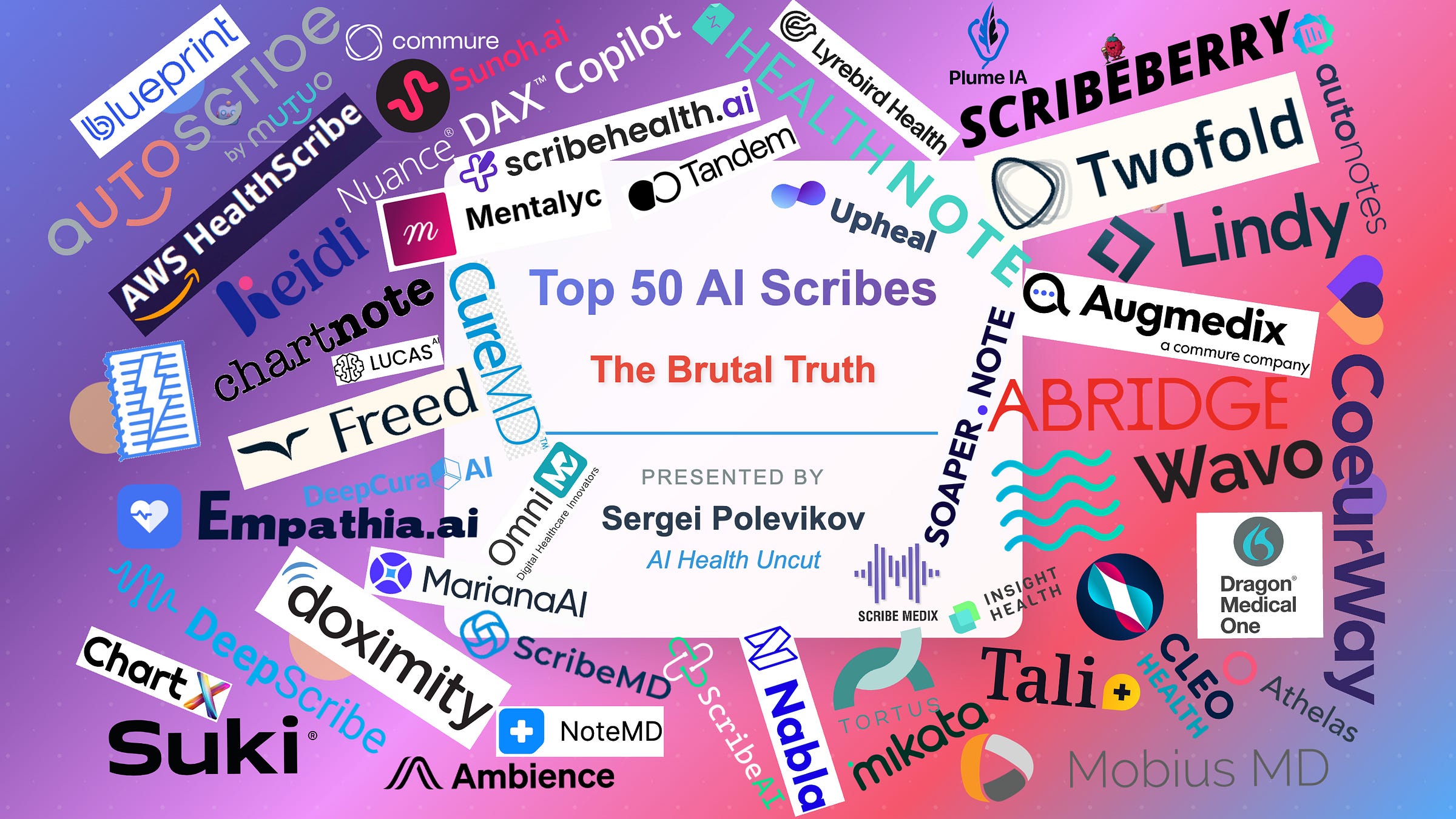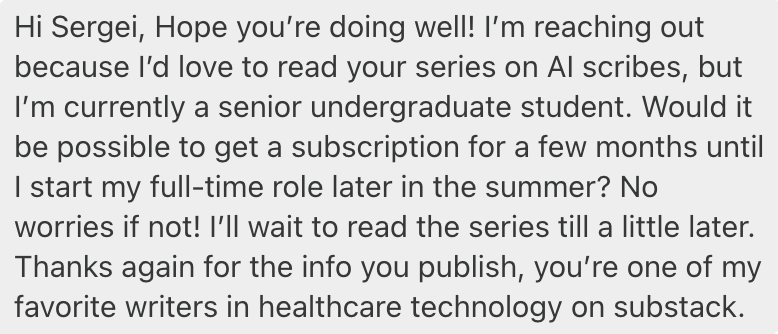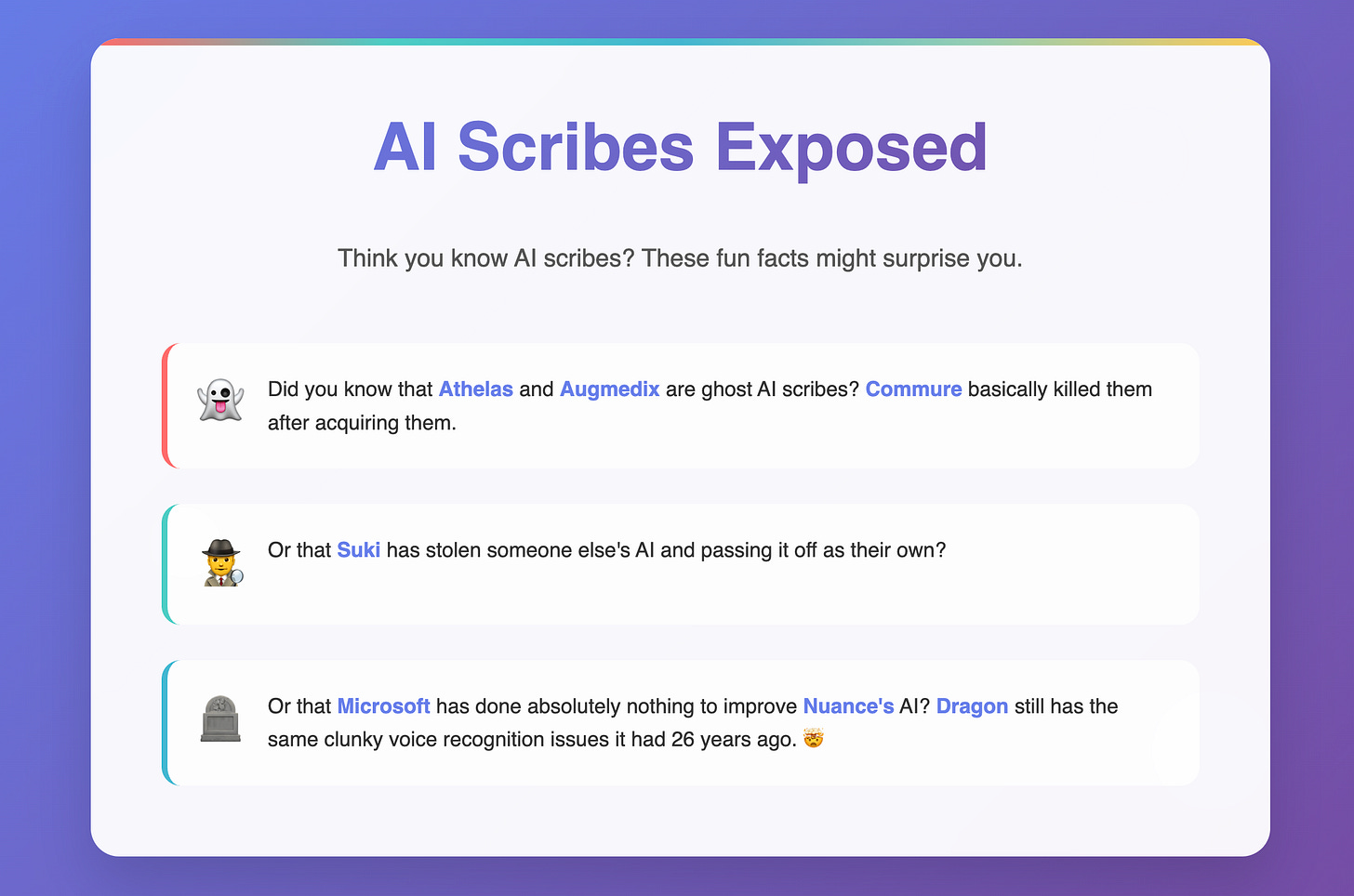Top 50 AI Scribes: The Brutal Truth [Part 4 of 4]
The one and only ranking of 50 most popular AI scribes based on actual user experience.
Welcome to AI Health Uncut, a brutally honest newsletter on AI, innovation, and the state of the healthcare market. If you’d like to sign up to receive issues over email, you can do so here.
All right, we’ve finally made it: Part 4 of the 4-part series “Top 50 AI Scribes: The Brutal Truth”. Wasn’t so bad, was it. 😉
This final part is the culmination of my AI scribe research — likely the only place where you’ll find personal, often R-rated, opinions and reviews of medical AI scribes from both me and the clinicians I’ve spoken to.
DISCLAIMER: I’ve said it before, but it bears repeating. I’m not promoting anything. No sponsors, no advertisers, no bosses. No one pays me to say nice things, or mean things. I have zero incentives to hype up or trash any company or their products. I have no personal investments in any companies mentioned here either. I’m my own man. These AI scribe rankings are based solely on clinician-user interviews, my personal testing, and independent research.
Before we begin, I want to take a moment to thank all of my supporters. I’m often very critical of certain things happening in AI and healthcare. But I promise you, it’s only because I genuinely care and want to make things better for all of us. So, thank you for your understanding.
I receive a lot of messages daily, and I always respond promptly to every one of them. Most are incredibly kind and supportive.
I want to highlight one recent message in particular. A student reached out asking for full, paywall-free access to my Substack. Of course, I granted it—as I always do.
This brings me to another important message. If you cannot afford this article—perhaps you’re a student or currently between jobs—please reach out. That’s precisely why I created the AI Health Uncut Founding Member Club. Thanks to generous donations and support from these wonderful individuals, I’m able to provide access to anyone who needs it. By the way, students reach out frequently, and I’m always glad to help.
If you’d like to become a Founding Member of the AI Health Uncut community, you can join through this link. You’ll be making a real impact, helping me continue to challenge the system and push for better outcomes in healthcare through AI, technology, policy, and beyond.
Some readers are asking me:
“Why are you spending so much time on AI scribes?”
Well, here’s my answer: There’s currently zero FDA oversight. AI scribes are copying each other, running wild, and the market has mushroomed with AI tourists and knockoffs—thank you, AI-vibe coding! Clinicians are bombarded daily by these fly-by-night apps. I’m here to separate the legit from the bullshit.
In Part 1 four weeks ago, I explored the broader AI scribe landscape, analyzed adoption rates, and investigated why some clinicians enthusiastically embrace AI scribes while others remain deeply skeptical.
In Part 2 three weeks ago, I unpacked the fiery discussion from the recent Digital Health Inside Out episode titled “Why the Hell Do We Need 126 Medical AI Scribes?” featuring Brendan Keeler, Alex Lebrun, Bobby Guelich, my co-host Alex Koshykov, and yours truly. Notably, Brendan Keeler and I engaged in a vigorous yet respectful debate regarding the commoditization of AI scribes and the role—good, bad, and ugly—of venture capital.
In Part 3 two weeks ago, I went directly to the source—clinician-users—to figure out critical questions head-on. Do AI scribes genuinely represent innovations in value-based care, or are they just Revenue Cycle Management (RCM) tools disguised as clinical support? Additionally, I assess their real-world integration success within EHR systems and scrutinize claims of saving clinicians time and money.
In this Part 4, I’ll finally look at the data, presenting a head-to-head comparison of the 50 most popular AI scribe tools. This evaluation is strictly from a user’s practical standpoint—no marketing bullshit allowed. Specifically, I compare:
Pricing
Note Accuracy & Quality
Editing Burden (time and effort required for revisions)
Integration & Workflow (ease of practical use within EHR systems)
Specialty Fit & User Trust
Ambient, Yes/No?
Academic/Peer Review/Empirical Validation, Yes/No?
AI Tourist, Yes/No?
Funding source: traditional VC-backed (VC), private equity (PE), institutional (INST), angel (ANGEL), bootstrapped (BOOT), parent (PARENT), or spun off (SPIN).
Let’s run that horserace: 50 top AI scribes, and why doctors hate ‘em or love ‘em.
https://youtube.com/shorts/qUL9kpQWTX8
I’ve been thinking about the best way to present this. I decided to go with a summary table featuring color-coding—green, yellow, and red—for good, neutral, and bad performance across the 50 most popular AI scribes. And I’m not actually going to put rank numbers on each AI scribe. I’ll just list them alphabetically.
Honestly, a 300-page book would be needed to cover everything on AI scribes—which might actually be a great idea. What do you think?
If you have specific questions, just reach out. Readers who have reached out before can hopefully vouch that I respond swiftly to every inquiry.
Think you know AI scribes? These fun facts might surprise you.
👻 Did you know that Athelas and Augmedix are ghost AI scribes? Commure basically killed them after acquiring them.
🕵️♂️ Or that Suki has stolen someone else’s AI and passing it off as their own?
🪦 Or that Microsoft has done absolutely nothing to improve Nuance’s AI? Dragon still has the same clunky voice recognition issues it had 26 years ago. 🤯
And that’s just the tip of the iceberg. Read the full piece for more.
Once you start digging, it’s the Wild West out there.
Alright, let’s do this!
Keep reading with a 7-day free trial
Subscribe to AI Health Uncut to keep reading this post and get 7 days of free access to the full post archives.







